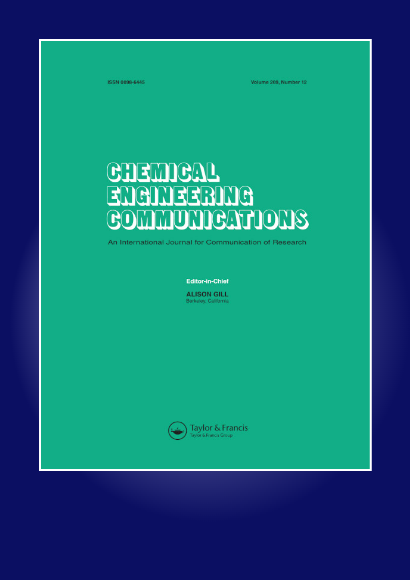海藻酸钠生物聚合物与十二烷基硫酸钠在水介质和不同添加剂溶液中不同温度下的相互作用
IF 2
4区 工程技术
Q3 ENGINEERING, CHEMICAL
引用次数: 2
摘要
摘要采用电导率法研究了十二烷基硫酸钠(SDS)和海藻酸钠(NaAlg)在水盐/水相(HDT)介质中通过改变胶束参数(如临界胶束浓度(CMC)、胶束电离程度(α)和结合反离子(β))和SDS + NaAlg混合物胶束热力学的相互作用。通过电导率与[SDS]对照图评估CMC值和α值。SDS + NaAlg在aq电解质和aq HDTs介质中的胶束化增强。在水和10% (w/w)甘油(GLY)溶液中,SDS + NaAlg胶束的形成随着温度的升高而延迟,而在其他溶剂中,随着工作温度的升高,胶束的形成有利于SDS + NaAlg胶束的形成。从CMC的温度依赖性出发,计算了SDS + NaAlg混合物的热力学。ΔG0m的值在所有实验中均为负值,因此进行了检查。SDS + NaAlg混合物在H2O、H2O +乙酸钠(NaOAc)、H2O +苯甲酸钠(NaBenz)和H2O + 4-氨基苯甲酸(4-ABA)介质中胶束的ΔHm0值均为正,因此在这些溶剂中胶束过程为吸热过程。SDS + NaAlg在10% (w/w)甘油(GLY)溶液和298.15和303.15 K的H2O + NaCl溶液中均发生放热胶束化。SDS + NaAlg的ΔHm0和ΔSm0值表明,在电解质和HDT介质中,疏水、范德华和放热相互作用是SDS与NaAlg相互作用的驱动力。关键词:甲基疏水相互作用亲水海藻酸钠十二烷基硫酸钠热力学数据可用性声明我们的数据作为电子补充材料提供。披露声明作者未报告潜在的利益冲突。资助研究人员支持项目编号(RSP2023R360),沙特阿拉伯利雅得沙特国王大学。本文章由计算机程序翻译,如有差异,请以英文原文为准。
Interaction of sodium alginate biopolymer with sodium dodecyl sulfate in aqueous medium and different additive solutions at several temperatures
AbstractInteractions between sodium dodecyl sulfate (SDS) and sodium alginate (NaAlg) in aq. salts/hydrotrope (HDT) media have been investigated using conductivity method with changing the micellar parameters (e.g., critical micelles concentration (CMC), extent of micelle ionization (α), and bound counterions (β)) and thermodynamics of the micellization of SDS + NaAlg mixtures. CMC values and α were assessed from the plots of conductivity versus [SDS]. The micellization of SDS + NaAlg was enhanced in aq. electrolyte and aq. HDTs media. The formation of SDS + NaAlg micelles was found to happen delayed with an increase in temperature in water and aq. 10% (w/w) glycerol (GLY) solution, while in other employed solvents, micelle creation was observed to favor with an upsurge of working temperature. Thermodynamics of SDS + NaAlg mixtures were computed from temperature dependency of CMC. The values of ΔG0m were found negative for all the experiments, thereby, examined. The values of ΔHm0 in the micellization of SDS + NaAlg mixtures in H2O, H2O + sodium acetate (NaOAc), H2O + sodium benzoate (NaBenz), and H2O + 4-amino benzoic acid (4-ABA) media were observed positive, and, hence, the process was endothermic in these solvents. Micellization of SDS + NaAlg was exothermic in 10% (w/w) glycerol (GLY) solutions at all temperatures and in H2O + NaCl at 298.15 and 303.15 K. The values of ΔHm0 and ΔSm0 for SDS + NaAlg show that the hydrophobic, van der Waals and exothermic interactions are the driving forces between SDS and NaAlg in electrolytes and HDT media.Keywords: CMChydrophobic interactionhydrotropessodium alginatesodium dodecyl sulfatethermodynamics Data availability statementOur data are provided as electronic supplementary material.Disclosure statementNo potential conflict of interest was reported by the authors.Additional informationFundingResearchers Supporting Project number (RSP2023R360), King Saud University, Riyadh, Saudi Arabia.
求助全文
通过发布文献求助,成功后即可免费获取论文全文。
去求助
来源期刊

Chemical Engineering Communications
工程技术-工程:化工
CiteScore
5.50
自引率
4.00%
发文量
80
审稿时长
6 months
期刊介绍:
Chemical Engineering Communications provides a forum for the publication of manuscripts reporting on results of both basic and applied research in all areas of chemical engineering. The journal''s audience includes researchers and practitioners in academia, industry, and government.
Chemical Engineering Communications publishes full-length research articles dealing with completed research projects on subjects such as experimentation (both techniques and data) and new theoretical models. Critical review papers reporting on the current state of the art in topical areas of chemical engineering are also welcome; submission of these is strongly encouraged.
 求助内容:
求助内容: 应助结果提醒方式:
应助结果提醒方式:


